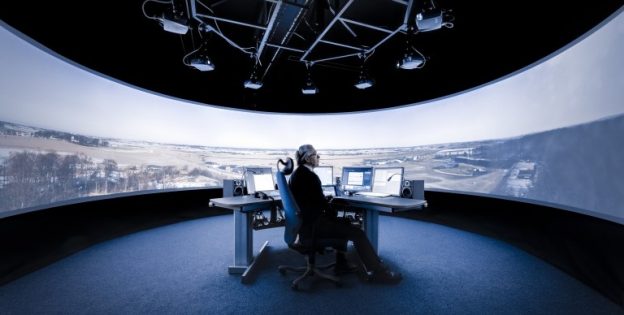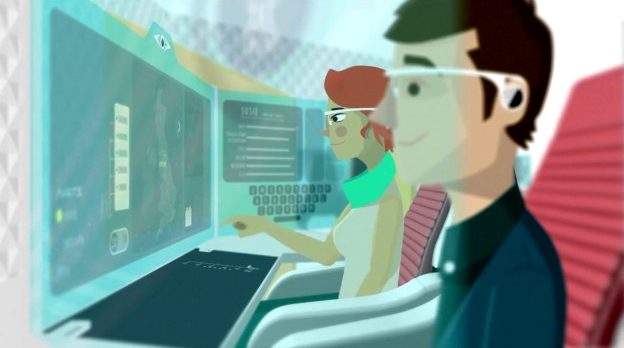Is this the end for the air traffic control tower?
12 August 2014From Edinburgh’s sleek lines to Sydney’s helter-skelter, the air traffic control tower is often an iconic airport landmark. But could its days be numbered?
The introduction of remote control towers is one of the most exciting technological developments in the history of our industry. Alongside the advent of secondary radar and electronic flight strips, it could revolutionise the provision of air traffic services.
The idea of controllers using high definition cameras and remote sensing equipment to manage airport traffic from potentially hundreds or even thousands of miles away is a tantalising prospect.
For smaller airfields there are obvious cost saving benefits. Not only would a physical tower no longer need to be constantly manned and maintained, a remote tower could potentially provide a service to entire groups of small airfields, offering economies of scale that might make the difference between an airport staying open or closing.
This is exactly what’s about to start happening in Sweden, where two small airfields with low levels of traffic are to receive regulatory approval for ‘remote control’ this autumn.
For larger airports there are more challenges, but nothing insurmountable. Cameras would have to be well located and probably at a height comparable to a control tower itself. However, moving to a remote system would free up valuable airport real estate, while negating the need for an iconic – and therefore expensive – building.
There are potential safety and resilience benefits to consider too. Using cameras and screens means you are no longer limited by what the human eye can physically see out of the window. An augmented reality HUD would put vital operational information right in front of the controller, overlaid on the aircraft and airport itself in real-time. Infrared cameras could help cut through light fog, while a Google Glass type interface might one day even present specific data to individual controllers.
From the ANSP’s point of view there are potentially huge cost and efficiency benefits. Groups of controllers could be validated to work for a number of different airports from a single remote tower facility – perhaps even located in an existing en-route control centre.
For NATS, we’re excited by what remote towers could mean for our airports business and we’re currently in discussions with a number of manufacturers and service providers to understand where the opportunities may lie. Interestingly we have had a remote tower facility as a contingency for Heathrow since 2009, albeit without ‘windows’!
There are questions still to be answered about regulation and the ability to consistently stream huge amounts of data between the airport and remote tower, but in many ways that’s only an extension of the technology we’re using today. We are already reliant on getting information from the ground and air to the tower. Is it so different if that tower happens to not physically be at the airport? And in the event of the cameras not operating, it would be no different to the low visibility procedures that we’re already so well practiced in today.
I’m in little doubt that this is the next big thing for our industry, but are we moving towards a time when physical control towers won’t be needed at all? We’ll see.
[Header image: SAAB]
Comments
Please respect our commenting policy and guidelines when posting on this website.






12.08.2014
15:28
Terry Logg
This sounds like an April Fools’ joke. Who writes this type of nonsense!?
12.08.2014
16:26
Steve Balfour
The airport operator will still have to pay the ATCOs Paul, no matter where they’re sitting.
12.08.2014
18:19
Johan Grauers
True Steve, however a larger scale operation can gain from efficency increases based on the scale. For example you can make a more efficent admin team with a larger unit, the area centers have already been reduced throughout both the UK and Europe to increase efficency. If Remote towers do become the norm then I would expect that the tower functions would be merged into the area centers, thereby increasing efficency both for the ANSP and the customers.
Thanks for the update Paul. This project is something I take a great deal of interest in for many reasons. I look forward to seeing the trial progress in Sweden and I am hoping we will see one in the UK in the future as well.
13.08.2014
04:31
Misha Rastov
Terry Logg, you need to open your eyes and embrace the future. Why do we need physical concrete and glass towers when the technology exists to conduct operations remotely, from anywhere?
I suppose you think that towers should still be using Very pistols/flares and aldis lamps to communicate with aircraft, not this new fangled radio malarky.
13.08.2014
11:28
Marcelo
A very interesting concept indeed. I believe that with time we will move towards something similar. However, just like the post suggested it is very far away. Other things to consider would also be connection cut outs due to weather possible adverse weather conditions where the “remote control tower” is located etc…
13.08.2014
21:13
Christian
No different to tele-medicine which has been around some time now and well utilised; can’t stop progress……
14.08.2014
02:37
Brian Fleck
It will not happen here in the US anytime soon. New replacement towers are being cranked out here every year. That being said….it is something we have definitely talked about eventually being a possibility.
14.08.2014
10:36
Sam
The Swedish model is misleading as many of their airfields are run by one entity, more as a social service than a profitable business. Not sure how two UK airports owned by two separate owners would feel about an ATCO controlling both ADC positions at the same time (EGAA & EGAC springs to mind). Which takes priority?
What about multi sector validations? The regulator has, in the past, only allowed such an idea for airfield ATCOs as holiday relief. Presumably there is a plan in place to change this!? What about manning levels? There are many, many questions and hurdles to overcome before this becomes a reality.
Look at it this way, we were told over twenty years ago that we wouldn’t retire as ATCOs because technology would supersede us…………..I’m still here………
14.08.2014
10:41
Teresa Banobre
The only con I can see is the one that delocalizations bring, as for “Call centres”, finally no one lives in and understands the local peculiarities. Results are a less human service. Many Call centres are being re-localised lately for this reason.
14.08.2014
20:58
JP Lesueur
This means that ICAO DOC4444 Chapter 7 should be completely rewritten.
ICAO requests for an aerodrome controller that “Watch shall be maintained by VISUAL observation”. When Eurocontrol tried after 5 years of studies to introduce A-SMGCS to replace “visual observation”, even with strong visibility limitation, it was rejected to Doc7030 EUR part…
Even if most countries set up this tool at a lot of airports without taking any consideration to the published rules (built on a safety case…) there is a big difference between making ATC a safe organisation and setting up projects to make money…
30.08.2014
12:26
Jason Gill
Great article Paul.
For those who doubt the possibilities or the push that may come commercially on this just look at the constant push from airports and operating authorities to reduce costs. Where do most costs lie in aviation, and particularly ATC, its in the people. Pay, Pensions, T&C’s can’t continue upwards whilst operating costs for an ANSP are constantly pushed downwards.
I remember the days we were told that Simulation for flying training wasn’t any substitute for real time in an aircraft. Well, having “flown” military and civil simulators I can tell you it is, and in some cases can count towards hours, a valid substitute.
Also having sat in at Towers and then sat in on 3D simulator runs for Heathrow I can tell you its not long after the door closes that the bums in seats act just like its for real with the same stress levels and concerns as in the real tower. Some will argue that Simulator pressure comes from the need to pass that sim run or from other than real life ATC pressure, but its how one handles that pressure that is important not the source of the pressure. The CAA even now mandates that ATC has to have some Sim time for Emergencies training, where it can be done safely, this is in line with Aircrew requirements for the same reason.
Once VR headsets become a standard (Oculus Rift anyone?) and the lines between virtual and real become even more blurred then I see only one direction this will go.
Yes the Regulator will take time to get there (we have had 20 years of GPS and still we fly most tracks based on VOR/DME’s in the UK) but get there they will and if the UK is to maintain its slender lead in ATC then get there they must.
13.09.2014
05:57
Ung
Smart Thinking. The tower has the sensors, the staff sit in a room close by or far away. Makes no difference. Now the biggest challenge to convince the old generation of ATC people. Guess they complained about radar, ADS-B, GPS etc in the past, but now this is all established technology. The capability to overlay aircrafts on a video screen with flight details, very cool. Augmenting the visual images with radar, also great, instead of seeing fog and snow through the ATC tower windows, getting the picture but all available technology. Great SAAB